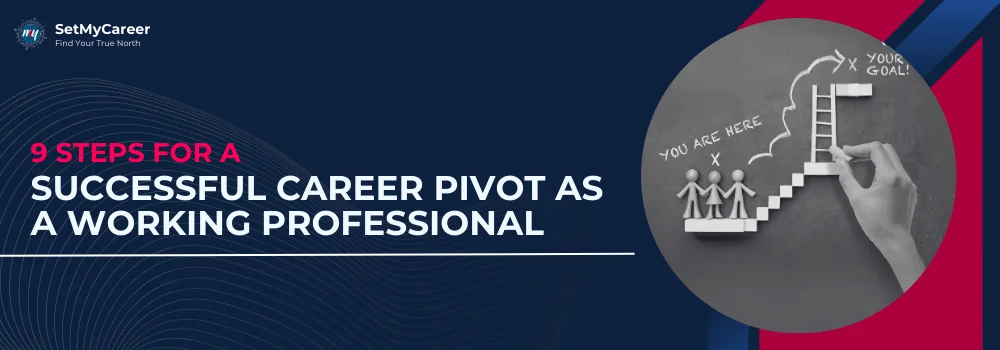Published by Jyothi Patil on 4 April 2024
Content Strategist | Editorial Team Member
Jyothi Patil is a skilled writer with a strong background in English literature, which she applies to crafting engaging content across various platforms. From writing blogs for her website and guest posts to creating pieces on Medium and Substack, Jyothi excels in making complex ideas easy to understand.
Feeling stuck in your career? This guide provides a 9-step plan for a successful career pivot to a more fulfilling path without starting over.

Picture this: you're a senior finance manager at a multinational corporation. You've been steadily climbing the corporate ladder for over a decade. You're great at your job, respected by your peers, and making a comfortable six-figure income.
But underneath that successful mask, you're deeply unfulfilled. Your passion lies elsewhere — perhaps in entrepreneurship, non-profit work, or an entirely different field.
Sound familiar?
Well, many working professionals find themselves in similar situations, yearning for a career change but paralyzed by the thought of starting over.
The good news is that you don’t really have to quit your job or forfeit your hard-earned skills and experience. This guide will walk you through a strategic 9-step process to pivot your career as a working professional.
A career pivot refers to a significant shift in your professional path without completely restarting from scratch. Unlike a full career change, where you might go back to school or start an entry-level job in a new field, a pivot allows you to leverage your existing skills, experience, and network to transition into a new role or industry more seamlessly.
For example, an experienced marketing manager could pivot into a marketing consultant role, utilizing their strategic and client management expertise while gaining more autonomy and work-life balance. Or an accountant might pivot into financial planning, combining their numbers prowess with a growing interest in helping individuals manage their wealth.
If several of these signs resonate with you, it may be time to consider a career pivot to rediscover your professional spark.

Shift gears confidently with the right career pivot plan
Make the MoveWhat truly motivates and energizes you?
What are you innately good at?
What do you really crave?
Aligning your future career with your intrinsic values and strengths is crucial. To gain clarity, take self-assessment tests or psychometric career test. List out your top 5 values and indicate how your current role serves those values. For interests, what topics most excite you outside of work? Ask yourself, where do you see yourself in the next 5 years? When you feel satisfied with your ‘ideal picturesque’ life, start visualizing it and take necessary steps to achieve them, one by one.
Armed with self-knowledge, explore alternative career avenues that could be a good pivot fit based on your values, interests and strengths. Some options are as follows:
Make a list of 8-10 potential paths to research. Browse job descriptions, growth potential, daily responsibilities, education/training required. Attend industry events or setup informational interviews to gain first-hand insights
As a working professional, you've accumulated a wealth of valuable skills that can transfer to a new path. Make an inventory of yours, including:
Speaking with a career coach or a career mentor can help identify transferable skills based on your current role. This exercise will illuminate what you already have in your arsenal for a smoother pivot.
After exploring potential paths, you may identify certain skills, knowledge or education needed to pivot successfully. Create a plan to acquire those:
The goal is to strategically upskill while maintaining your current role and income as long as needed.
Depending on your target path, you may experience a temporary pay cut or gap in income. Get your finances in order:
If you are married or have to take care of the dependents or elderlies, it’s advised to have an open discussion around budgets, lifestyle impact and their support during the career transition.
Your resume, LinkedIn profile, elevator pitch etc. need to be reoriented for your new target path. Update these to highlight most relevant job interview skills, responsibilities and accomplishments.
For the CV Writing in particular, reconfigure it with your pivot in mind. Emphasize different aspects and change up the wording to your target domain. Subtle shifts in language can make a big difference.
Create a portfolio of work samples like reports, presentations or recommendation letters you can showcase as well.
Your professional networking is a pivotal asset as a working professional looking to switch careers. Reactivate old connections and initiate new ones in companies, roles and industries of interest. Some tips include the following:
Be transparent about exploring new paths and seek advice on potential openings or people to connect with.
Before fully committing to your pivot path, test it out on a trial basis. Take on freelancing, consulting projects or volunteer roles to gain practical exposure.
Beyond experience, it demonstrates your budding interest to prospective employers. Think creatively - maybe an internal project related to your target domain, pro-bono advising for startups, or teaching classes.
Any foothold to get first-hand work under your belt will ease the eventual pivot.
Once you've upskilled, rebranded and built relevant experience, it's time to land your ideal pivot opportunity. Key steps involve the following:
Consider negotiating an extended time off from your current role if making a major career pivot. But don't quit prematurely until you've secured your next step.
Pivoting careers as an experienced professional requires strategic preparation but is absolutely achievable. By leveraging your existing strengths, supplementing in gap areas, and both repackaging your experience appropriately while trying on the new path, you can reinvent into a role better aligned with who you are today.
lIt's never too late to reclaim your professional spark, and if you need any support navigate this journey alone, our experts at SetMyCareer are here to guide you!
No. 14/595, 1st Floor, Nanjappa Reddy Layout, Koramangala 8th Block, Bangalore 560095